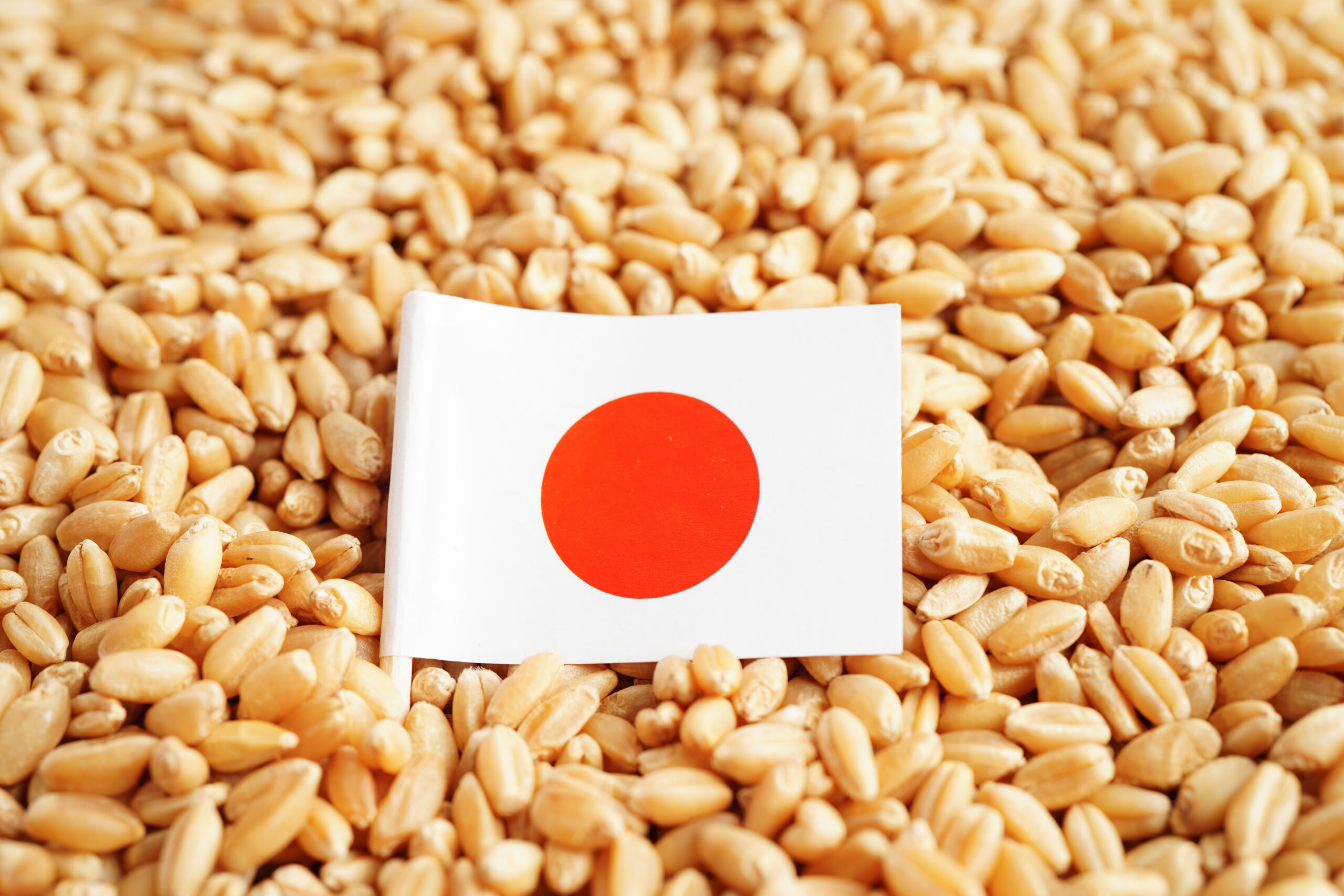Japan, a nation characterized by its rich culinary traditions and reliance on imported food, finds itself navigating a complex landscape within the global wheat trade. With domestic production struggling to meet demand, and global market fluctuations affecting prices and availability, the economic impact of wheat is significant. This article explores the various facets of Japan’s wheat trade, examining its historical context, key players, and the challenges and opportunities that lie ahead in this crucial sector.
Japan’s Wheat Trade: A Crucial Economic Landscape
Wheat is a staple food in Japan, underpinning many cultural dishes from ramen to bread. The economic landscape of the country is heavily influenced by this grain, as Japan imports around 80% of its wheat needs, positioning it as one of the world’s largest wheat importers. The reliance on imported wheat not only affects food security but also drives domestic farmers to adapt and innovate in an effort to compete within an increasingly globalized market.
The economic implications of this dependency are profound. The volatility of global wheat prices can significantly alter the cost of food products domestically, impacting both consumers and businesses. Furthermore, as international trade agreements evolve, Japan must navigate the complexities of tariffs and quotas that could affect the price and availability of imported wheat.
Additionally, Japan’s wheat trade is intertwined with broader economic policies, including agricultural subsidies and support for farmers. The government plays a crucial role in regulating these dynamics to ensure that domestic production does not collapse amid heavy import competition.
In light of these factors, the wheat trade in Japan is not just an agricultural issue but a multifaceted economic challenge that touches on food security, consumer prices, and international relations.
As the nation continues to wrestle with these dynamics, it becomes clear that the future of Japan’s wheat trade will require innovative solutions and cooperative strategies to ensure a stable and sustainable food supply.
A comprehensive understanding of this economic landscape is essential for stakeholders, including farmers, policymakers, and consumers, as they look to navigate the complexities of the wheat trade in Japan.
Historical Overview of Japan’s Wheat Imports and Exports
The history of wheat in Japan dates back centuries, but it was not until the Meiji Era (1868-1912) that wheat began to be cultivated on a larger scale. Initially introduced through Western influences, wheat became a staple food alongside rice, leading to significant shifts in agricultural practices. However, domestic production has never fully satisfied Japan’s wheat needs, resulting in a reliance on imports that has persisted throughout the 20th century.
The aftermath of World War II saw a dramatic increase in wheat imports as Japan sought to rebuild its economy. The United States emerged as a primary supplier, providing wheat through various trade agreements, which laid the groundwork for modern import policies. Over the decades, Japan implemented a series of policies to manage wheat production and imports, attempting to balance domestic agricultural interests with the needs of its population.
The early 2000s marked a pivotal shift in Japan’s wheat import strategy, particularly following the 2007-2008 global food crisis. Rising prices and export restrictions from major wheat-producing countries prompted Japan to diversify its import sources. This period also saw the introduction of the "import quota" system, which aimed to protect local farmers by limiting the volume of imported wheat.
In recent years, Japan has continued to rely heavily on imports, with suppliers such as the United States, Canada, and Australia dominating the market. The nation’s imports have been characterized by a focus on quality, with Japan often opting for premium varieties of wheat to meet its culinary standards.
Japan’s historical relationship with wheat imports has created a complex dependency that is difficult to untangle. This legacy shapes current trade practices and will significantly influence future strategies as the nation seeks to secure its wheat supply.
Understanding this historical trajectory allows for a nuanced perspective on the current challenges and opportunities within Japan’s wheat trade, which must be considered by policymakers and stakeholders in the agricultural sector.
Key Players in Japan’s Wheat Supply Chain
The wheat supply chain in Japan is a complex network comprised of various stakeholders, each playing a critical role in the overall system. On one end of the spectrum are the farmers, who, despite the high levels of import dependency, contribute to domestic wheat production. A small number of farmers cultivate wheat, primarily focusing on specialty varieties that can command higher prices due to their quality.
The government also plays a pivotal role in the supply chain, implementing policies designed to support farmers and manage imports. The Ministry of Agriculture, Forestry, and Fisheries (MAFF) regulates wheat imports and offers subsidies to encourage domestic production. This regulatory framework aims to balance support for local farmers while ensuring consumers have access to affordable wheat.
At the same time, major importers and trading companies operate as key players in the supply chain. They negotiate contracts with suppliers around the world, navigating fluctuating prices and ensuring timely deliveries to meet Japan’s needs. These companies often have extensive networks of relationships with international wheat producers, allowing them to source various quality grades and types of wheat.
Milling companies are another crucial component of the supply chain. They transform raw wheat into flour, which is then distributed to bakeries, restaurants, and food manufacturers. The milling industry in Japan is characterized by advanced technology, which ensures high-quality flour production that meets the specific demands of the Japanese market.
Retailers and food service providers also play significant roles in shaping consumer demand. They influence the types of wheat products available to consumers and are essential in driving trends in the market. As consumer preferences shift towards healthier and more diverse options, retailers are increasingly focused on sourcing specialty wheats that cater to these demands.
Ultimately, the interplay among these key players highlights the complexity of Japan’s wheat supply chain. It is a dynamic system that must adapt to changing economic conditions, consumer preferences, and global market trends, all of which are crucial for ensuring food security and maintaining the quality of wheat products in Japan.
Economic Significance of Wheat in Japan’s Food Security
Wheat’s role in Japan’s food security cannot be overstated, as the grain is a primary source of calories for a significant portion of the population. With wheat-based products like bread, noodles, and pastries forming an integral part of the Japanese diet, its availability directly impacts nutritional standards in the country. The reliance on imported wheat creates vulnerabilities, particularly in times of global supply chain disruptions or price fluctuations.
The economic significance of wheat goes beyond mere consumption. It is a critical component of Japan’s food processing industry, which contributes substantially to the national economy. Flour milling, for example, plays a significant role in generating employment and supporting related sectors such as baking and food manufacturing. The interconnected nature of these industries underscores the importance of a stable wheat supply.
Moreover, the government recognizes wheat as a strategic commodity in terms of national security. Ensuring a consistent supply of wheat is vital not only for health and nutrition but also for maintaining social stability. The government’s efforts to manage imports and support domestic production reflect an understanding of these broader implications.
Furthermore, changes in consumer preferences towards healthier and more diverse food options are influencing the wheat market. As demand for whole grain and specialty products increases, there is an opportunity for domestic producers to cater to these trends, thereby enhancing food security through local production.
The economic significance of wheat extends to international trade relations as well. Japan’s status as a major importer makes it a key player in global wheat markets, influencing pricing and availability. As Japan navigates its trade agreements and relationships with exporting countries, the implications of these interactions are felt domestically, affecting everything from food prices to agricultural policy.
In conclusion, wheat is not just a commodity in Japan; it is a cornerstone of food security and economic stability. The complexities surrounding its supply and demand highlight the need for strategic planning and international cooperation to ensure a resilient and sustainable wheat trade.
Domestic Production vs. Import Dependency: A Balancing Act
Japan’s agricultural landscape is characterized by a complex balancing act between domestic production and import dependency. On one hand, the government strives to bolster domestic wheat production to reduce reliance on imports; on the other, the realities of agricultural economics and consumer demand often dictate a continued dependence on foreign sources.
Domestic wheat production in Japan has been challenged by various factors, including a declining agricultural workforce and increasing competition from imported wheat. Although the government has implemented policies to promote local farming through subsidies and support programs, the volume of domestically produced wheat remains insufficient to meet national demand. As a result, Japan has turned to international markets to fill the gap, leading to an overwhelming reliance on imports.
The import dependency raises concerns about food security, particularly in the face of global price volatility and supply chain disruptions. The COVID-19 pandemic, for example, highlighted the vulnerabilities of relying heavily on foreign suppliers. In response, there have been calls for greater self-sufficiency in wheat production, with a focus on enhancing agricultural innovation and sustainability.
To successfully balance domestic production and import dependency, Japan must address several challenges. Investing in agricultural technology, providing incentives for young farmers, and improving the efficiency of farming practices are all critical steps toward increasing domestic output. Additionally, fostering a market for locally produced wheat through consumer education can help stimulate demand for domestic products.
The government is also exploring ways to facilitate trade relationships with exporting nations, ensuring a reliable supply of wheat while promoting local production. This dual approach allows Japan to maintain access to high-quality imported wheat while simultaneously striving for greater food self-sufficiency.
Ultimately, achieving a balance between domestic production and import dependency will require concerted efforts from all stakeholders, including government, farmers, and consumers. The future of Japan’s wheat trade hinges on finding this equilibrium, ensuring both food security and economic stability for the nation.
Global Wheat Market Trends Impacting Japan’s Trade
The global wheat market is continually evolving, influenced by factors such as climate change, geopolitical tensions, and shifting consumer preferences. These trends have significant implications for Japan’s wheat trade, shaping import strategies and domestic policies in response to changing circumstances.
One of the most pressing global trends is climate change, which has led to unpredictable weather patterns and decreasing agricultural yields in some wheat-producing regions. Extreme weather events, such as droughts and floods, can drastically affect global wheat supply and prices. For Japan, which relies heavily on imports, these fluctuations can create challenges in securing a stable and affordable supply of wheat.
Geopolitical tensions also play a significant role in the global wheat market. Trade disputes, sanctions, and conflicts can disrupt supply chains and lead to price volatility. For instance, tensions between major wheat producers like Russia and Ukraine can have ripple effects across the global market, impacting supply availability for countries like Japan. As Japan navigates these complexities, it must be agile in adapting its import strategies to mitigate risks.
Additionally, shifting consumer preferences towards healthier and more sustainable food options are prompting changes in the wheat market. There is growing demand for organic and whole grain wheat products, which can create opportunities for both domestic producers and importers. Japan’s food industry is increasingly responsive to these trends, indicating a potential shift in the types of wheat products that are prioritized in imports.
The rise of technology in agriculture also presents both challenges and opportunities for Japan’s wheat trade. Innovations such as precision farming and advanced milling technologies can enhance productivity and product quality. As these technologies become more prevalent, Japan may need to rethink its strategies for both domestic production and imports to remain competitive in the global wheat market.
In summary, global wheat market trends significantly impact Japan’s trade dynamics, shaping its policies and strategies for import and domestic production. By closely monitoring these trends and adapting accordingly, Japan can better navigate the complexities of the wheat trade and secure a stable food supply for its population.
Trade Agreements Shaping Japan’s Wheat Market Dynamics
Trade agreements play a pivotal role in shaping the dynamics of Japan’s wheat market, influencing both import strategies and domestic agricultural policies. In recent years, Japan has engaged in several key trade agreements that have redefined its relationships with major wheat-exporting countries.
The Trans-Pacific Partnership (TPP) and its successor, the Comprehensive and Progressive Agreement for Trans-Pacific Partnership (CPTPP), mark significant milestones in Japan’s trade policy. Through these agreements, Japan has sought to lower tariffs on imported agricultural products, including wheat. By reducing trade barriers, Japan aims to secure more favorable terms for wheat imports from member countries, which include the United States, Canada, and Australia.
In addition to the CPTPP, Japan has also focused on strengthening bilateral trade agreements with key wheat exporters. The Japan-Canada Economic Partnership Agreement, for example, allows for tariff reductions on wheat imports, enhancing Japan’s access to high-quality Canadian wheat. These agreements reflect Japan’s strategic approach to diversifying its import sources and ensuring a consistent supply of wheat.
Moreover, Japan’s trade agreements are designed to strike a balance between supporting domestic farmers and securing reliable imports. While the government aims to protect local agricultural interests, it recognizes the need to secure foreign supplies to meet consumer demand. This dual focus is essential for maintaining food security while fostering competitiveness in the agricultural sector.
The evolving landscape of global trade relations also presents challenges for Japan’s wheat market. Changes in tariffs, trade restrictions, or geopolitical tensions can impact the stability of wheat supplies. Japan must remain vigilant in monitoring these developments and adapting its trade agreements to safeguard its interests.
Ultimately, trade agreements are crucial in shaping the dynamics of Japan’s wheat market. By fostering relationships with key exporting countries and negotiating favorable terms, Japan can navigate the complexities of the global wheat trade and ensure a stable supply for its population.
Challenges Facing Japan’s Wheat Export Competitiveness
Despite being a major importer of wheat, Japan faces challenges when it comes to enhancing its competitiveness in wheat exports. The country’s agricultural sector has historically focused on domestic production to meet local needs, leading to an underdeveloped export market for wheat, which poses significant hurdles in a global trade environment.
One of the primary challenges is Japan’s high production costs. Factors such as limited arable land, labor shortages, and stringent quality standards contribute to elevated costs that make Japanese wheat less competitive on the global market. While consumers in Japan prioritize quality, this emphasis can hinder the ability to produce wheat at a price point that is appealing to international buyers.
Furthermore, Japan’s domestic market is often prioritized over export opportunities. As a result, wheat varieties that are cultivated are largely tailored for domestic consumption, limiting the potential to explore diverse markets abroad. This focus on local preferences can stifle innovation and restrict the development of a robust export strategy.
Regulatory challenges also impede Japan’s efforts to expand its wheat exports. The country’s stringent food safety and quality regulations, while essential for protecting consumers, can complicate the export process. Navigating these regulations can be cumbersome for potential exporters, leading to delays and increased costs that deter participation in global markets.
Additionally, competition from other wheat-exporting nations poses a significant challenge for Japan. Countries like the United States, Canada, and Australia, with their established agricultural infrastructures and lower production costs, dominate the global wheat market. The ability of these countries to offer competitive prices makes it difficult for Japan to carve out a niche in wheat exports.
To address these challenges, Japan must focus on developing a comprehensive export strategy that includes investing in technology and innovation to enhance productivity, reducing production costs, and exploring new markets. Promoting the unique qualities of Japanese wheat, such as its premium quality and diverse applications, could help create a distinctive brand identity in international markets.
In conclusion, Japan’s wheat export competitiveness faces numerous challenges, from high production costs to regulatory hurdles. By addressing these issues head-on and fostering a proactive approach to international trade, Japan can work towards establishing a more competitive presence in the global wheat market.
The Role of Technology in Wheat Trade Efficiency
Technology plays a transformative role in enhancing the efficiency of Japan’s wheat trade, from production and processing to distribution. As the industry grapples with challenges such as rising costs and global competition, the integration of advanced technology becomes increasingly critical for improving productivity and market responsiveness.
In domestic wheat production, innovations such as precision farming are gaining traction. This approach employs data-driven techniques to optimize planting, irrigation, and harvesting processes. By utilizing sensor technology and satellite imaging, farmers can monitor crop health and yield potential, allowing for more efficient use of resources and maximization of output. As a result, domestic wheat production can become more competitive, reducing the reliance on imports.
The milling and processing sectors also benefit from technological advancements. Modern milling technology, including computerized systems for grading and blending wheat, enhances the quality and consistency of flour production. These improvements not only meet high consumer standards within Japan but also position Japanese flour products favorably in the international market.
Supply chain management is another area where technology plays a crucial role. The implementation of digital platforms and logistics solutions enables better tracking of wheat shipments from international suppliers. By improving transparency and reducing delays, these technologies can enhance the efficiency of wheat imports, ensuring timely availability for domestic consumers.
Furthermore, the rise of e-commerce and online marketplaces is reshaping the distribution of wheat products. Retailers are increasingly utilizing digital platforms to reach consumers directly, allowing for greater accessibility and convenience. As consumer preferences evolve, technology enables the food industry to adapt rapidly and meet changing demands.
However, while technology presents numerous opportunities, it also requires investment and training. Ensuring that farmers and industry stakeholders are equipped with the necessary skills to adopt new technologies is essential for maximizing their benefits. Government support and collaboration with educational institutions can facilitate this process, helping to build a more technologically advanced agricultural sector.
In summary, technology is a critical enabler of efficiency in Japan’s wheat trade. By embracing innovation across the supply chain, from production to distribution, Japan can enhance its competitiveness and navigate the complexities of the global wheat market with greater agility.
Environmental Considerations in Wheat Production
Environmental sustainability is a growing concern within Japan’s wheat production and trade dynamics. As the global agricultural sector faces increasing scrutiny over its impact on climate change and natural resources, Japan must address environmental considerations to ensure the long-term viability of its wheat trade.
One of the primary environmental challenges is water usage. Wheat production is highly dependent on irrigation, and in regions where water scarcity is a concern, this can lead to over-extraction of water resources. Implementing sustainable irrigation practices, such as drip irrigation and rainwater harvesting, can help mitigate these challenges and promote more efficient use of water in wheat farming.
Soil health is another critical factor in sustainable wheat production. Practices such as crop rotation and cover cropping can enhance soil fertility and reduce erosion, ultimately leading to more resilient agricultural systems. As Japan seeks to promote domestic wheat production, integrating sustainable farming practices will be essential for maintaining soil health and productivity over time.
Moreover, the impact of agriculture on biodiversity cannot be overlooked. Intensive farming practices can lead to habitat loss and a decline in local biodiversity. Encouraging agroecological practices that promote biodiversity, such as mixed cropping and preserving natural habitats, can enhance the sustainability of wheat production and contribute to ecosystem health.
The carbon footprint associated with wheat trade, particularly transportation, is also an area of concern. As Japan relies heavily on imported wheat, the emissions generated from shipping can contribute to greenhouse gas emissions. Transitioning to more sustainable transportation options and investing in renewable energy sources can help reduce the environmental impact of wheat trade.
Additionally, consumer awareness and preferences are shifting towards sustainably produced foods. As Japanese consumers increasingly prioritize environmental considerations, there is a growing demand for organically produced wheat and environmentally friendly practices. Aligning domestic production with these consumer preferences can create opportunities for domestic farmers to thrive in the market.
In conclusion, addressing environmental considerations in wheat production is essential for ensuring the sustainability of Japan’s wheat trade. By adopting sustainable practices and responding to consumer preferences, Japan can work towards a more environmentally friendly agricultural system that balances economic viability with ecological responsibility.
Future Prospects for Japan’s Wheat Trade Landscape
The future of Japan’s wheat trade landscape is shaped by a multitude of factors, including technological advancements, changing consumer preferences, and evolving global market dynamics. As Japan navigates these complexities, several prospects emerge that could redefine its approach to wheat trade in the coming years.
One promising avenue is the continued integration of technology into agriculture and trade. Innovations in precision farming, data analytics, and supply chain management can enhance productivity and efficiency within the wheat sector. By leveraging these advancements, Japan can improve its domestic wheat production capabilities








